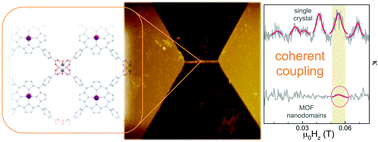Vanadyl spin qubit 2D arrays and their integration on superconducting resonators†
Abstract
Vanadyl systems have been shown to possess superior quantum coherence among molecular spin qubits. Meanwhile two-dimensional (2D) networks of spin qubit nodes could provide a means to achieve the control of qubit localization and orientation required for implementation of molecular spin qubits in hybrid solid-state devices. Here, the 2D metal–organic framework [{VO(TCPP)}Zn2(H2O)2]∞ is reported and its vanadyl porphyrin node is shown to exhibit superior spin dynamics and to enable coherent spin manipulations, making it a valid spin qubit candidate. Nanodomains of the MOF 2D coordination planes are efficiently formed at the air–water interface, first under Langmuir–Schaefer conditions, allowing mono- and multiple layer deposits to be transferred to a variety of substrates. Similar nanodomains are then successfully formed in situ on the surface of Nb superconducting coplanar resonators. Transmission measurements with a resonator with a 14 μm-wide constriction allow to estimate that the single spin-photon coupling G1 of the vanadyl spins in the nanodomains is close to being optimal, at ca. 0.5 Hz. Altogether, these results provide the basis for developing a viable hybrid quantum computing architecture.



 Please wait while we load your content...
Please wait while we load your content...